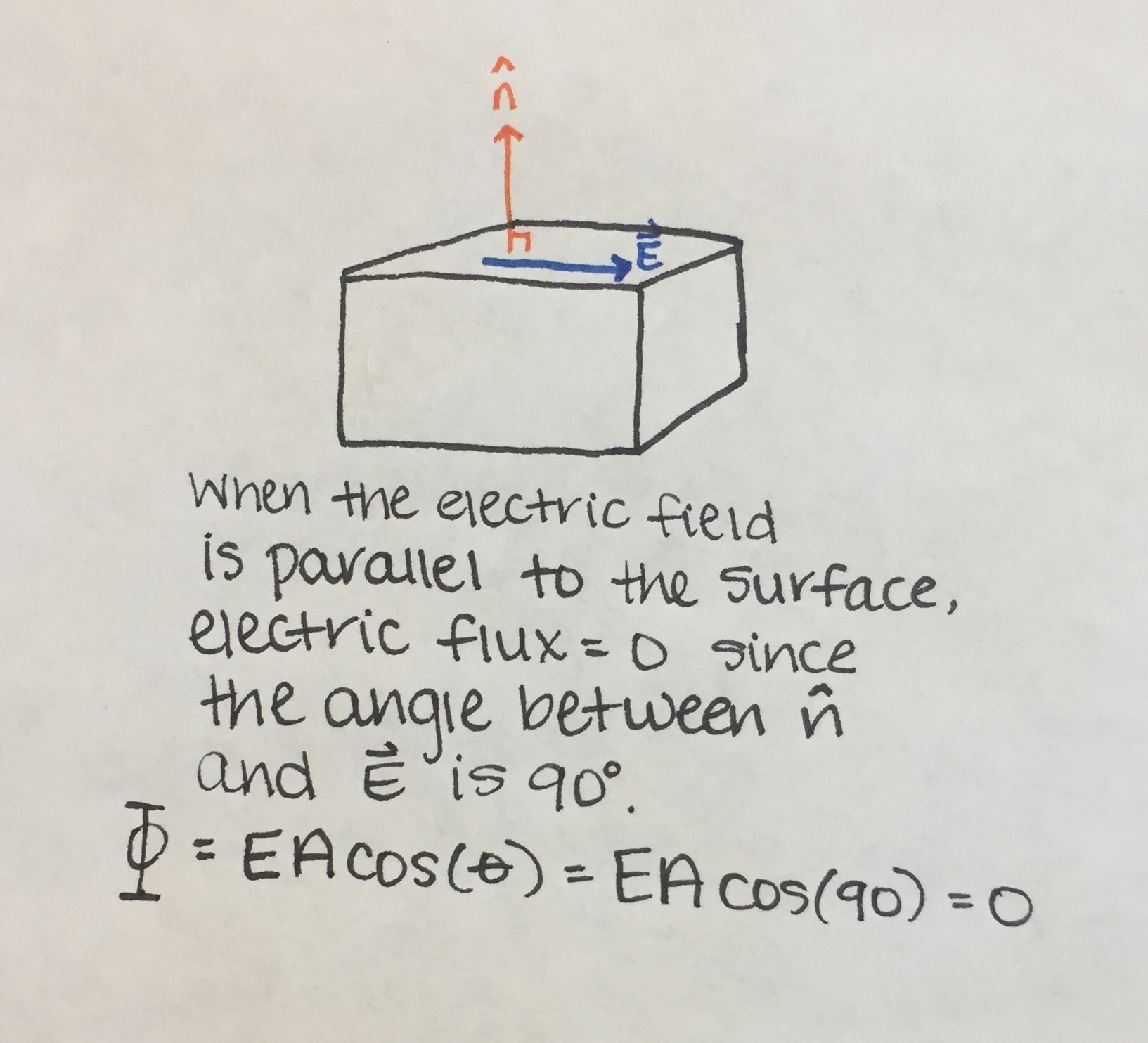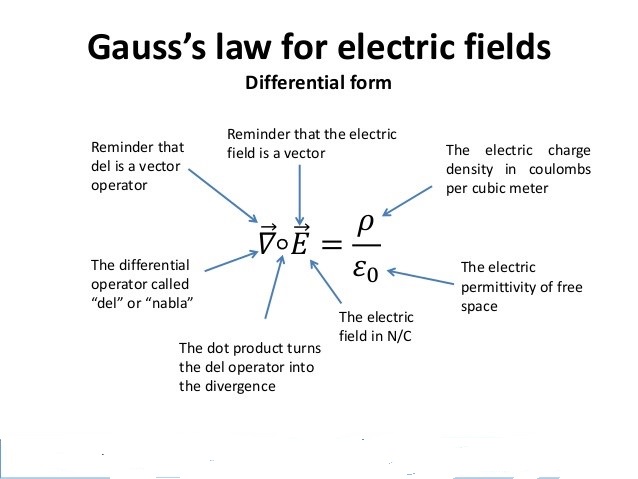Gauss's Flux Theorem
Claimed by Marian Mitchell (SPRING 2017)
This is a page about Gauss's Flux Theorem. A work in progress by Jeff Patz
The Main Idea
Gauss's Flux Theorem is a way of relating charge distribution inside of a closed surface to its resulting electric field. Analyzing the direction and magnitude of the electric field present on a closed surface helps in understanding the total sum of the charge on the inside of the closed surface. The mathematical model (as shown below) used to related electric field and charge distribution displays that there is a proportional relationship between the amount of electric field passing through a surface and the amount of charge inside of the surface. This application of Gauss's Flux Theorem can be applied to a surface with any shape and size. Since Gauss's Law uses the superposition principle in order to find the sum of all of the charges inside of a closed surface, charges present on the outside of the surface contribute no net flux and produce no electric field on the surface of the object.
A Mathematical Model
In words, the electric flux of a closed surface is equal to the total charge enclosed in the closed surface over the constant epsilon naught. The electric flux of a closed surface is also equal to the surface integral of the electric field evaluated over the closed surface.
[math]\displaystyle{ \Phi_E = \frac{\Sigma q}{\varepsilon_0} = \oint_C E\bullet \hat{n} dA }[/math]
Where E is the electric field, dA is the infinitesimal area in the direction of the electric field, [math]\displaystyle{ \hat{n} }[/math] is the unit normal vector, sigma q is the sum of the charges inside the closed surface, and the dot denotes a dot product.
For the special case of a constant electric field, the electric flux is equal to the electric field over the closed surface multiplied by the area and the cosine of the angle between the two vectors.
[math]\displaystyle{ \Phi_E = EAcos(\theta) }[/math]
Where E is the electric field, A is area of the surface, and [math]\displaystyle{ \theta }[/math] is the angle between the E and A
A Computational Model
Gauss's Flux Theorem is able to be visualized by observing the direction and angle of an electric field traveling through a given surface.
It is always important to note the angle between the n-hat vector and the electric field. If that angle is perfectly perpendicular, the contributed electric flux will be zero.

It is also important to note the sign (positive or negative) of the electric flux, with respect to the direction of the electric field. If the electric field is pointing into the surface, the flux will be negative. If the electric field is pointing out of the surface, the electric flux will be positive.

Examples
Easy
One Surface and Uniform Electric Field
A disk of radius 5 centimeters is in an area of uniform electric field with magnitude 400 Volts/Meter. The angle between the electric field and the disk is 35 degrees.
Using the simplified version of Gauss's Law because the electric field is uniform: [math]\displaystyle{ \Phi_E = EAcos(\theta) }[/math], fill out the known values, which in the case is all values needed.
[math]\displaystyle{ \Phi_E = (400)(\pi0.05^2)cos(35) }[/math]
[math]\displaystyle{ \Phi_E = 2.573 }[/math] Volt Meters
Middling
Multiple Surfaces and Uniform Electric field
An equilateral prism lies on top of a rectangular prism with dimensions l = 5cm, w = 7cm, h = 19cm, and is in an area of uniform electric field with magnitude 560 Volts/Meter perpendicular to the long sides of the rectangular prism.
Using the simplified version of Gauss's Law because the electric field is uniform: [math]\displaystyle{ \Phi_E = EAcos(\theta) }[/math]
First of all it is important to note that there are four surfaces that contribute to the net electric flux. two of the two long sides of the equilateral prism and two of the long sides of the rectangular prism. We know the angles between E and A because the top prism is an equilateral triangle, so all the side angles are 60 degrees. With this equation we can write:
[math]\displaystyle{ \Phi_E = E[(w*h)cos(120) + (w*h)cos(60) + (w*h)cos(180) + (w*h)cos(0)] }[/math]
[math]\displaystyle{ \Phi_E = 0 }[/math]
Difficult
Non-Uniform Electric Field
A solid sphere of radius R has a charge +Q uniformly distributed throughout. Find the Electric field at locations r1<R, r2>R.
For this problem we can utilize the equality of [math]\displaystyle{ \frac{Q}{\varepsilon_0} = \oint_C E\bullet dA }[/math]
For r1<R, we know the line integral of dA is just the circumference of the gaussian surface we took, a sphere of radius r1.
[math]\displaystyle{ \frac{Q}{\varepsilon_0} = E\bullet 4\pi r_1^2 }[/math]
Since we're taking a portion of the sphere we need to find the portion of the charge that is inside of the Gaussian surface. This is as easy as a ratio of volumes.
[math]\displaystyle{ q = \frac{3Q}{4\pi r_1^3}*\frac{4\pi R^3}{3} }[/math]
[math]\displaystyle{ q = Q\frac{r_1^3}{R^3} }[/math]
[math]\displaystyle{ E = Q\frac{r_1}{4\pi R^3} }[/math]
Differential Form
Coulomb's law has a critical flaw when it comes to calculating the electric field at some location near a quick-moving charge. This problem called Relativistic Retardation occurs at pretty much all occasions, unless the charge is not moving at all or moving extremely slow as compared to the speed of light. Relativistic Retardation is due to the fact that the electric field calculation depends on the origin of a charge (i.e. the location where it started moving), not the current location of the charge. So if the charge has moved from its starting location, then the electric field calculation is wrong in Coulomb's law, which also means that it is inconsistent with the theory of special relativity.
Gauss's Law does not have this critical flaw and is consistent with relativity due to a property called Divergence. Conceptually, Divergence is a way to measure electric fields at some point in time as compared to a source charge at that same point in time; so the property of Divergence is the reason that Gauss's Law does not experience Relativistic Retardation. Divergence is defined as the amount of electric flux in an object as the limit of that object's volume goes to zero.
The formula which expresses divergence is called The Differential Form of Gauss's Law:
- [math]\displaystyle{ \nabla \cdot \mathbf{E} = \frac{\rho}{\varepsilon_0} }[/math]
where the
Divergence is Relativistically Correct
This is called a local relationship between charge and field, because the charge and the divergence property are evaluated at the same location and time, rather than at different locations and times. This avoids the problems of relativistic retardation and forma=s the basis for what is called a local field theory that is consistent with special relativity
Connectedness
Most of the applications of Gauss's Law are finding the electrical fields of different shapes. It can be observed that using Gauss's Law can assist in finding the derivation of the electric field for objects such as a sphere, sheet of charge, and cylinder. This use of Gauss's Law is especially useful in the field of Physics due to its aid in simplifying the calculations (as opposed to using Coulomb's Law) in finding the total charge inside a closed surface. Furthermore, the use of electric flux in Gauss's Flux Theorem assists in studying and understanding Faraday's Law and its applications to objects such as electrical generators, transformers, and inductors.
Because I am an industrial engineer, Gauss's Law is particularly interesting to me. It proportionally relates electric field to charge within an object. Industrial engineering deals with a lot of probability and numerical methods, so proportionality relationships really interest me and help when understanding the "big-picture" of a concept. It is relatively intuitive to think that electric fields and charges would some-how be related, but being able to actually quantify that relationship through Gauss's Law is very important and interesting.
History
Friedrich Gauss was born in 1777. He was an extremely intelligent child, many considered him a prodigy. He started making mathematical computations and discoveries in his teen years. And in 1835, formulated Gauss's Law as a different way to derive Coulomb's Law. He made many other discoveries in the fields of mathematics, statistics, probability, and number theory.
Today, Gauss's Law remains as one of Maxwell's equations, which are the four equations that make up classical electrodynamics. Maxwell's four equations are Gauss's Law for electricity, Gauss's Law for magnetism, incomplete version of Faraday's Law, and Ampere's Law.
See also
Further reading and Examples
http://www.physics.umd.edu/courses/Phys263/wth/fall04/downloads/Gauss/divergence.pdf
https://www.youtube.com/watch?v=zn5ObHtGWeg
External links
http://web.hep.uiuc.edu/home/serrede/P435/Lecture_Notes/A_Brief_History_of_Electromagnetism.pdf
http://www.storyofmathematics.com/19th_gauss.html
References
http://hyperphysics.phy-astr.gsu.edu/hbase/electric/gaulaw.html



